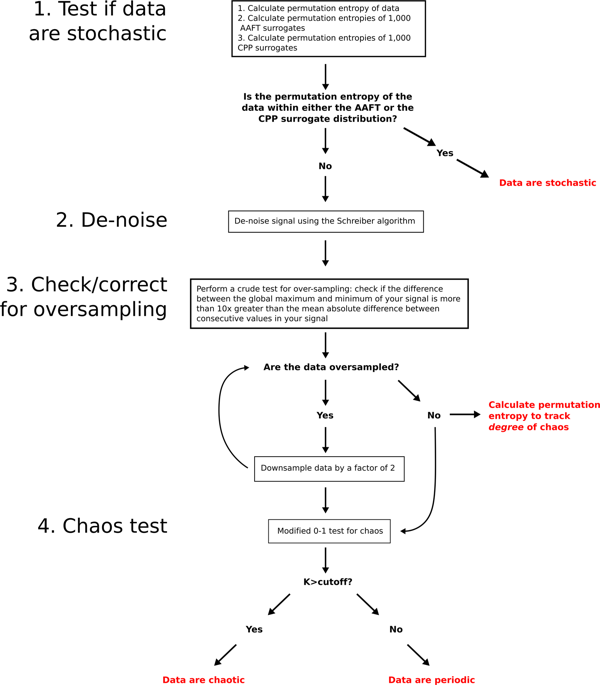当前位置:
X-MOL 学术
›
Commun. Biol.
›
论文详情
Our official English website, www.x-mol.net, welcomes your feedback! (Note: you will need to create a separate account there.)
A simple method for detecting chaos in nature.
Communications Biology ( IF 5.9 ) Pub Date : 2020-01-03 , DOI: 10.1038/s42003-019-0715-9 Daniel Toker 1 , Friedrich T Sommer 1 , Mark D'Esposito 1
Communications Biology ( IF 5.9 ) Pub Date : 2020-01-03 , DOI: 10.1038/s42003-019-0715-9 Daniel Toker 1 , Friedrich T Sommer 1 , Mark D'Esposito 1
Affiliation

|
Chaos, or exponential sensitivity to small perturbations, appears everywhere in nature. Moreover, chaos is predicted to play diverse functional roles in living systems. A method for detecting chaos from empirical measurements should therefore be a key component of the biologist's toolkit. But, classic chaos-detection tools are highly sensitive to measurement noise and break down for common edge cases, making it difficult to detect chaos in domains, like biology, where measurements are noisy. However, newer tools promise to overcome these limitations. Here, we combine several such tools into an automated processing pipeline, and show that our pipeline can detect the presence (or absence) of chaos in noisy recordings, even for difficult edge cases. As a first-pass application of our pipeline, we show that heart rate variability is not chaotic as some have proposed, and instead reflects a stochastic process in both health and disease. Our tool is easy-to-use and freely available.
中文翻译:

一种检测自然界混沌的简单方法。
混沌,或者说对小扰动的指数敏感性,在自然界中随处可见。此外,预计混沌将在生命系统中发挥多种功能作用。因此,从经验测量中检测混沌的方法应该是生物学家工具包的关键组成部分。但是,经典的混沌检测工具对测量噪声高度敏感,并且会因常见的边缘情况而崩溃,因此很难检测测量噪声较大的领域(例如生物学)中的混沌。然而,较新的工具有望克服这些限制。在这里,我们将几个这样的工具组合到一个自动化处理管道中,并表明我们的管道可以检测噪声录音中是否存在混乱,即使对于困难的边缘情况也是如此。作为我们管道的首次应用,我们表明心率变异性并不像一些人提出的那样混乱,而是反映了健康和疾病的随机过程。我们的工具易于使用且免费提供。
更新日期:2020-01-04
中文翻译:

一种检测自然界混沌的简单方法。
混沌,或者说对小扰动的指数敏感性,在自然界中随处可见。此外,预计混沌将在生命系统中发挥多种功能作用。因此,从经验测量中检测混沌的方法应该是生物学家工具包的关键组成部分。但是,经典的混沌检测工具对测量噪声高度敏感,并且会因常见的边缘情况而崩溃,因此很难检测测量噪声较大的领域(例如生物学)中的混沌。然而,较新的工具有望克服这些限制。在这里,我们将几个这样的工具组合到一个自动化处理管道中,并表明我们的管道可以检测噪声录音中是否存在混乱,即使对于困难的边缘情况也是如此。作为我们管道的首次应用,我们表明心率变异性并不像一些人提出的那样混乱,而是反映了健康和疾病的随机过程。我们的工具易于使用且免费提供。


























 京公网安备 11010802027423号
京公网安备 11010802027423号